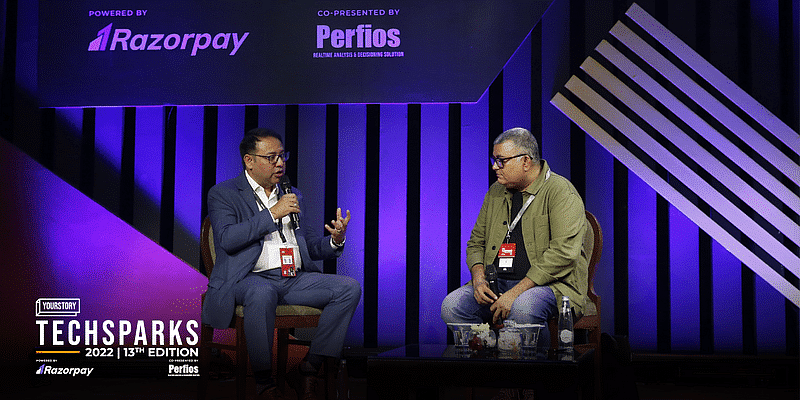Large-scale organisations often face several dynamics in their operating environments that can impact their innovation capacity. To institutionalise innovation entrepreneurship, the vision has to begin top down. It is important for leadership in organisations to create room for new ideas through a spiral process that emphasises the continuous evolution of innovation. Sabyasachi Goswami, CEO, Perfios Software Solutions, shared insights in a fireside chat at TechSparks 2022 on how organisations need to build knowledge tools, a culture of collaboration, and frameworks to adapt to constantly to develop and manage innovation.
The pillars of innovation
Sabyasachi set the tone of the discussion by defining what innovation is. “If you know what’s the problem and how you want to solve it, that really sums up what innovation is about,” he said. However, while the answer to innovating is simplified in words, most organisations struggle to incorporate innovation, especially as they scale. The answer to this lies behind knowing how to articulate and define the output, fuel the innovation engine, and identify the inputs required to get that. “Businesses focus too much on creativity. However, what is important is to measure and define the output you are looking for. Also, it is important that everyone in the organisation has context to your actions and also defined metrics for the innovations output,” he added.
When an organisation is innovating, there are a few things to be kept in mind, along with means to measure that. The measure of innovation can be put into three buckets – from the leadership bucket, the employees bucket, and the customer’s bucket. Within the leadership bucket it consists of identifying the percentage of innovation from crowdsourcing and open innovation, secondly the funding that leadership allocates to game changer versus tweaks to existing products and features, and the third is the time allocated for future versus running daily operations.
From an employee’s perspective, what is the percentage of teams or employees that are creating ideas leading to patents, or for innovation awards. What are the teams which are participating regularly for brainstorming and suggesting innovations. From a customers’ perspective, which of them are willing to provide a platform for your proof of concepts to come out with an innovative solution. “These tenets on the checklist are essential for innovation,” Sabyasachi added.
Identifying and enabling innovation
As organisations scale, it is important for them to stay humble, agile and also appreciate the effort and not just the outcome. While scaling it is also important to focus the mindset on innovation. “At Perfios, we created venturing and emerging products group (VPG). As a group they are empowered with finance, resources and ideas that they can flourish with a long-term view to disrupt. It is necessary to tweak your existing business models as the organisation becomes large,” said Sabyasachi, sharing an interesting insight about how beverage giant Coca Cola tweaked their business model in Africa.
While risk is the natural outcome of any new business innovation, organisations also need a coherent risk taking ability, which they can balance with the return. “Successful companies have been able to create a fine balance between using investor or stakeholder funds, but without sidelining the returns. So, while we work towards innovation, we cannot get over obsessed with problem solving or technology disruption that you are trying to build. Innovation needs a long-term view,” he added.
View from the top
As a business leader Sabyasachi said that he had seen multiple shifts in his career, from financial services, to technology and to fintech. “Perfios has grown from a 20-member team to now with 1,500 employees. In my own journey here, I have handled marketing, sales, operations, customer escalations, engineering among other aspects. It has helped me immensely to answer challenges that were coming towards us,” he said.
Speaking on success and failure of innovation, he said that Perfios started as a B2C company in 2008. “But we soon realised that it could become a lifestyle business, but not a brand. While that was our first failure, what it taught us was that whatever we built at the core, how we could take it to adjacent segments and turn it into vertical solutions,” he said. The shift soon resulted in success, when Perfios created products that dominated the market. “Today we are in 18 geographies, in India we service 850 clients and about 90 percent of India’s credit today goes through the Perfios engine,” he said.
On institutionalising innovation, Sabyasachi added that organisations need to move from the concept of know-it-all to learn-it-all. Most organisations become complacent when they become big, thinking that they know-it-all. “If we change to learn-it-all, it helps to stay grounded and bring out solutions. That is the success mantra I would prescribe,” he added.










![Read more about the article [Funding alert] Biotech startup immunitoAI raises $1M in seed round led by pi Ventures](https://blog.digitalsevaa.com/wp-content/uploads/2021/09/Imagezpdw-1631117249930-300x150.jpg)
